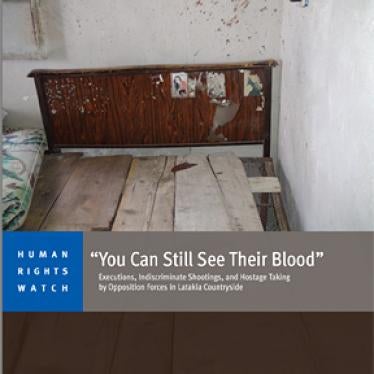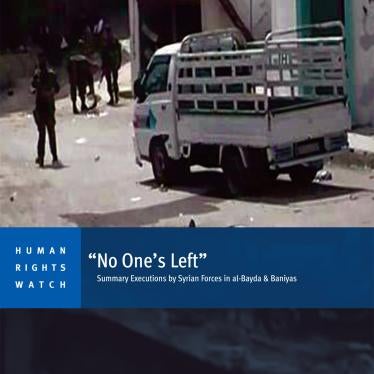(Tripoli) – Members of the Khamis Brigade, a powerful Gaddafi military force run by Muammar Gaddafi’s son Khamis, appear to have summarily executed detainees in a warehouse near Tripoli on August 23, 2011, Human Rights Watch said today. Within three days the same warehouse was set on fire but the cause is unknown, Human Rights Watch said.
Human Rights Watch inspected the charred skeletal remains of approximately 45 bodies, still smoldering, on August 27. The remains were spread throughout a warehouse in the Khalida Ferjan neighborhood in Salahaddin, south of Tripoli, adjoining the Yarmouk Military Base. At least two additional corpses were seen lying outside, unburned.
“Sadly this is not the first gruesome report of what appears to be the summary execution of detainees in the final days of the Gaddafi government’s control of Tripoli,” said Sarah Leah Whitson, Middle East and North Africa director at Human Rights Watch. “These merciless murders took place in the midst of Ramadan and those responsible should be brought to justice and punished.”
Human Rights Watch interviewed a survivor who said that guards at the warehouse, used as a prison, read out 153 names of detainees in the roll call the day of the killings. He estimated that 20 escaped from the attack and said that around 125 of the 153 detainees were civilians. Human Rights Watch observed that one building in the compound had spray-painted on it “32nd Brigade,” which is the official name of the Khamis Brigades.
Human Rights Watch spoke with one man who said he survived the shooting and grenade attack. Human Rights Watch also spoke to three others: one man who said he was detained in the warehouse until about August 10, a neighbor who heard the shooting and grenade explosions on August 23, and a National Transitional Council (NTC) fighter who discovered the remains on August 26, when the NTC forces first entered the area. Both detainees said they were civilians accused of supporting the rebels, and that no charges had been brought against them.
The survivor, Abdulrahim Ibrahim Bashir, 25, said that at sunset on August 23 guards of the Khamis Brigade opened fire on him and the other detainees from the roof, shooting through the roof’s tin sheeting, while another guard threw grenades in from the entrance. He survived by escaping over a wall while the guards were reloading their weapons.
Abdulrahim and the man detained earlier at the warehouse, Moiayad Abu Ghraim, 28, who was interviewed separately by Human Rights Watch, said that the commander overseeing the warehouse was Muhammad Mansour of the Khamis Brigade. Neither of them had ever seen him.
Abdulrahim said that Khamis Brigade members had held him in the warehouse for three months. The forces that detained him in his hometown of Ghadamis accused him of being “one of the revolutionaries.” He escaped his detention in the warehouse unharmed together with Abdulsalam and Hussain, last name unknown, who were brothers from Zlitan. The brothers were wounded after the guards began firing on them. Hussain later died.
Abdulrahim told Human Rights Watch:
Four soldiers climbed on the top of the warehouse, and another soldier opened the door. They started shooting at us through the roof. It was made of sheet metal. The guy at the door was throwing in grenades…I saw bullets and heard people saying Allahu Akbar, and that’s all. I saw [eight people] fall down. When [the guards] were refilling their ammunition, I ran out the door and jumped over the wall. I was not wounded, hamdullah. They just shot and killed us…
After I escaped, I saw one of the soldiers finish off anyone who was wounded lightly. He would just finish them off. I saw him from far away. He was wearing trouser fatigues and a civilian top. I recognized him. He was one of the ones guarding us. His name was Brahim and he was from Tajoura … After I escaped on August 23, I hid in a house outside the compound for three days, and saw that the guards were still there. Two other detainees were wounded with me. [The rebels] took Abdulsalam from Zlitan to the hospital [after they arrived three days later], but his brother Hussain died in my arms in the house. I left his body inside the house... The [warehouse] was already burning when the rebels came, but I didn’t see how it happened. I just saw it when the rebels came; it was already burnt, and black smoke was coming out. I left around sunset yesterday [August 26].
On August 27, Human Rights Watch counted approximately 45 distinct human remains in the ashes of the warehouse as well as other unidentifiable burned matter. Human Rights Watch also observed what appeared to be bullet holes in the tin roof of the warehouse. Smoke was still rising in one or two parts of the warehouse during the visit.
Human Rights Watch also interviewed an NTC fighter who said that he and his brigade found the warehouse while it was smoking when they seized the Yarmouk military base in Salahaddin on August 26. He told Human Rights Watch that as his brigade entered the base around noon, they went looking around. “We smelled it,” he told Human Rights Watch about their discovery.
Human Rights Watch did not have sufficient evidence to establish who or what started the fire.
According to the former detainee Moiayad, who was transferred out of the warehouse on August 10 to another detention facility near Tripoli, between 60 and 80 people were held at any given time at the warehouse. The guards there gave them food only sporadically and limited their water to one liter a day, despite the high summer heat. He said there were no lavatories. He told Human Rights Watch:
At one point we stayed 36 hours without food or water. After that they gave us each a cucumber to last us the entire day, and then on other days they would bring us a bowl of pasta, which was often almost raw, but [there was only enough for] each of us to eat five spoonfuls. The food wouldn’t be fed to a dog.
The guards also held him for six days, along with half a dozen others, in the hold of a small truck in the yard, Moiayad said.
A local resident who lived near the warehouse and had medical training said he heard the shooting and explosions on August 23. Neighbors then approached him to assist with the wounded. The man, who did not want his name disclosed, said:
Last Wednesday, sometime after the early evening prayer, I heard the sound of heavy gunfire and grenades, then complete calm. Then in the evening, my neighbors came to me. They asked if I could help people with gunshot wounds…I told them to take them to the hospital. [The neighbors] were scared to take them to the hospital, so they kept them [at home].
He told Human Rights Watch that Gaddafi forces had begun using the area outside of the Yarmouk military base since about early May. He said that the warehouse in which the detainees were held was previously an agricultural facility.
Under international humanitarian law, applicable during an armed conflict, violence to life and person, in particular murder of all kinds of civilians and persons not engaged in combat, such as detainees, is always strictly prohibited and constitutes a war crime. This is irrespective of whether the conflict is an international or non-international conflict. Murder can constitute a crime against humanity when committed as part of a widespread or systematic attack against a civilian population. Such an attack, meaning a state policy, could include a policy of executing detainees.
The two former detainees identified the names of the following detainees whom they believe were killed in the massacre:
Abdulrahim, Souk el-Juma
Muhammad, Zawiya
Ramadan Zreig, Zlitan
Tassir al-Tini, Ghadames, approximately 33 or 34
Baher al-Tini, Ghadames, approximately 33 or 34
Muhammad el-Lafi, Zawiya
Osama el-Lafi, Zawiya
Walid Sagar, Zawiya






